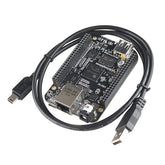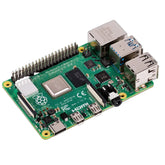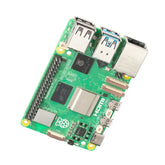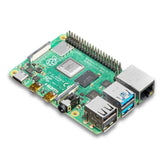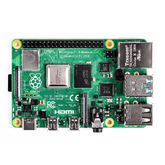Why Techies are Shifting from BeagleBone Black to Raspberry Pi?
Summary
Discover the intriguing shift in the tech world from BeagleBone Black to Raspberry Pi in our blog, "Why Techies are Shifting from BeagleBone Black to Raspberry Pi?" Uncover the tale of two boards, exploring their distinct features and applications. Delve into the reasons behind this transition, showcasing Raspberry Pi's cutting-edge capabilities. From diverse strokes to vibrant community support, witness the evolution of a preference. Join the conversation on the thriving ecosystem that sets Raspberry Pi apart. Engage with the tech revolution in our insightful journey, and draw your conclusions on this fascinating transformation! Click now for the full scoop.
The world of Single Board Computing (SBC) is dynamic and constantly changing. Two popular SBCs, Beaglebone Black and Raspberry Pi, lead this trend. But with tech enthusiasts increasingly favouring the Raspberry Pi over the Beaglebone Black, things are changing. Let’s take a closer look at why this trend occurs.

Introduction:
In the ever-evolving global of Single Board Computing (SBC), tech enthusiasts are always looking for the brand new and best. Among the popular choices, BeagleBone Black and Raspberry Pi were lengthy-status favourites. However, an exciting shift has been occurring – increasingly tech specialists are making a deliberate transfer from BeagleBone Black to Raspberry Pi. In this exploration, we'll dive into the reasons behind this migration and discover why Raspberry Pi is prevailing the hearts of techies.
A Story of Two Boards
BeagleBone Black:

Imagine BeagleBone Black as a mature engineer, equipped with powerful features like TI Sitara AM335 SOC application processor, 512MB DDR3L RAM, 4GB eMMC Flash etc. It is known for its expertise in deploying complex industrial IoT applications, making it the go to choice for the tech savvy.
Raspberry Pi:

Now, picture Raspberry Pi as the friendly companion, a small credit card-sized computer that can do almost anything a regular computer can. It runs on Linux, supports Python, and offers GPIO pins for connecting to sensors and actuators. It's like the all-in-one buddy for tech enthusiasts.
Different Strokes
|
Parameter |
Raspberry Pi |
BeagleBone Black |
|
Model Tested |
It's like the trusty Model B version. |
It's the reliable Rev A5 version. |
|
Processor Type |
Sporting the ARM11 processor. |
Armed with the ARM Cortex-A8 processor. |
|
RAM |
512 MB SDRAM. |
512 MB DDR3L. |
|
Processor Speed |
700 MHz. |
1 GHz. |
|
Flash |
Loading up with a dedicated SD Card socket. |
Utilizing 4GB (micro SD) for OS and data storage. |
|
Min Power |
power at 700mA (3.5W). |
minimum of 210mA (1.05W). |
|
GPIO Pins |
12 GPIO pins for versatility. |
69 GPIO pins. |
|
Dev IDE |
Engaging with IDLE, Scratch, Squeak/Linux. |
Utilizing Python, Scratch, Squeak, Cloud9/Linux. |
|
USB Master |
Dual USB 2.0 onboard for connectivity. |
A single USB 2.0 onboard. |
|
Audio Output |
Supporting HDMI and Analog audio output. |
Analog output for audio. |
|
Video Output |
Offering HDMI and Composite output. |
Not specifying a dedicated video output. |
|
UART |
Communicating with 1 UART for serial data. |
5 UARTs for serial data. |
|
No. of I/O pins |
8 Digital, 0 Analog pins. |
65 Digital, 7 Analog pins. |
Shop the powerful BeagleBone Black Rev C now!
The Shift: Raspberry Pi’s Edge
Computing Power and Memory: The Raspberry Pi packs in a better CPU and more memory, perfect for handling those demanding tasks. With up to 4GB of LDRDR4 RAM, the Raspberry Pi 4 is powerful.
- Price: Raspberry Pi keeps it wallet-friendly, starting at $35 for the 1GB variant, while the 4GB variant costs about $55. On the other side, BeagleBone Black hits the price tag at around $63.
- Versatility: Raspberry Pi becomes the Jack-of-all-trades, transforming into an Android TV Box, retro gaming arcade, Linux desktop, NAS, 3D printer, and more.
- Community Support: Raspberry Pi builds a community that feels like a family. It's been a core player in the SBC market, attracting a large and active user base, offering resources, education, and a sense of belonging.
Community Support and Ecosystem
1. Support and Ecosystem: Raspberry Pi is governed by unmatched community support and a great ecosystem. The Raspberry Pi Foundation fosters a global community, providing resources, classes and events for interested parties at all levels. The sheer number of features and variety of services contribute to the appeal of the Raspberry Pi.
BeagleBone Black, while having a capable community, finds it challenging to match the scale and variety of the Raspberry Pi community. The abundance of resources and the welcoming nature of the Raspberry Pi community make it a preferred choice for techies.
2. Accessibility and Affordability: The Raspberry Pi succeeds while remaining affordable without compromising performance. The variety of designs and affordability allows users to choose the one that best suits their needs and budget. These price-added factors have been the driving force behind the widespread adoption of the Raspberry Pi.
In contrast, BeagleBone Black, while feature-rich, leans towards the pricier side. The higher cost may pose a hurdle, especially for those with budget constraints or those exploring SBCs for educational purposes.
|
Feature |
Raspberry Pi 3 |
Beaglebone Black |
|
Basic Difference and History |
Single-board computer by Raspberry Pi Foundation |
Low-power open-source single-board computer by Texas Instruments |
|
Processor |
Broadcom BCM2835 (700MHz to 1.4GHz) |
TI AM3359 (1GHz ARM Cortex-A8) |
|
GPU |
VideoCore IV® Multimedia Co-Processor |
PowerVR SGX530 |
|
Memory |
512MB SDRAM |
512MB DDR3 |
|
Storage |
MicroSD card slot |
2GB 8-bit embedded MMC on-board flash |
|
USB Ports |
Dual USB 2.0 connectors |
2x 46 pin headers (USB 2.0) |
|
Video Output |
HDMI, Composite RCA (PAL and NTSC) |
Micro HDMI |
|
Audio Output |
3.5mm jack, HDMI |
Micro HDMI |
|
Dimensions |
8.6cm x 5.4cm x 1.7cm |
8.6cm x 5.3cm x 1.0cm |
|
Price |
$35 |
$45 |
|
Advantages |
Built-in 2.4GHz Wi-Fi, Easy Setup |
Extendable hardware with 92 expansion pins, On-board storage, GPIO functionality |
3. Broad Range of Applications: Raspberry Pi's adaptability steals the spotlight, making it suitable for home automation, media centres, retro gaming, or even the brain of a robotics project. GPIO pins add to its versatility, allowing connection to a wide array of sensors and devices.
BeagleBone Black, although powerful, may lack the same simplicity and ease of use across various applications. The user-friendly nature of Raspberry Pi makes it a favorite in diverse projects.
4. Performance and Specifications: Raspberry Pi keeps pushing boundaries with new models featuring enhanced performance. The Raspberry Pi 4, with a quad-core ARM Cortex-A72 processor, up to 8GB of RAM, and multiple USB 3.0 ports, ensures it stays competitive in the ever-evolving SBC landscape.
BeagleBone Black, while not lacking in performance, may not match the same performance-to-price ratio found in the latest Raspberry Pi models. The regular updates and advancements in Raspberry Pi specifications keep it a top choice for those seeking cutting-edge performance within a reasonable budget.
5. Education and Learning: Raspberry Pi becomes a trusted mentor in educational environments, serving as a valuable tool for teaching programming, electronics, and computer science. Specially designed kits and accessories, coupled with extensive documentation, make it an excellent choice for educators and learners alike.
Raspberry Pi's ecosystem proves conducive to introducing students to coding, hardware interfacing, and project-based learning. Its affordability becomes a key factor in making computing accessible for the next generation of tech enthusiasts.
Conclusion:
In wrapping up, while BeagleBone Black holds its ground as a powerful SBC with unique strengths, the shift towards Raspberry Pi is a mix of many factors. The vibrant community support, affordability, versatility in applications, ongoing performance improvements, and a significant role in education have propelled Raspberry Pi to the forefront of the SBC market.
As technology marches forward, the choice between BeagleBone Black and Raspberry Pi becomes a matter of personal preference, project requirements, and the specific needs of the tech community. Both platforms contribute to the rich world of single-board computers, catering to a diverse range of users. The friendly competition and innovation between these platforms benefit the entire SBC community, creating a dynamic and thriving environment for makers, developers, and tech enthusiasts. Whether one is drawn to the accessibility and widespread adoption of Raspberry Pi or the powerful capabilities of BeagleBone Black, the single-board computer landscape continues to evolve, promising exciting possibilities for the future of computing.
The shift from BeagleBone Black to Raspberry Pi among techies tells a story of Raspberry Pi's success in building a welcoming community, offering versatile applications, ensuring user-friendliness, being cost-effective, and gaining widespread industry acceptance. While both platforms have their strengths, the current trend suggests that Raspberry Pi has become the default choice for many developers and enthusiasts seeking a reliable and user-friendly single-board computer for their projects.



